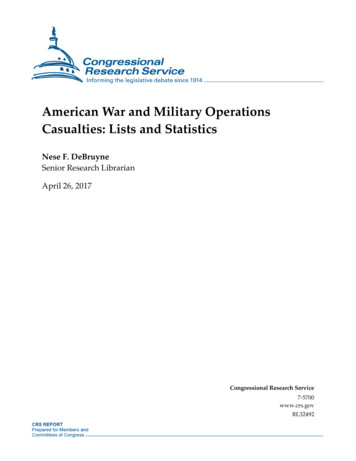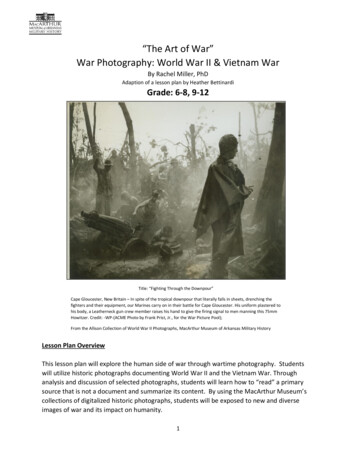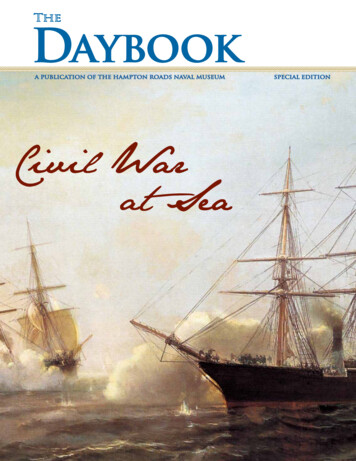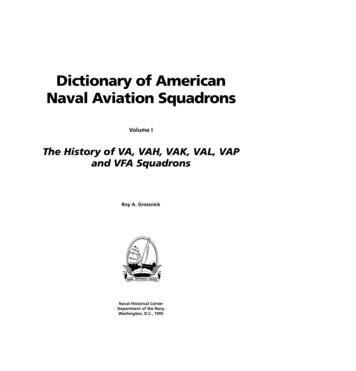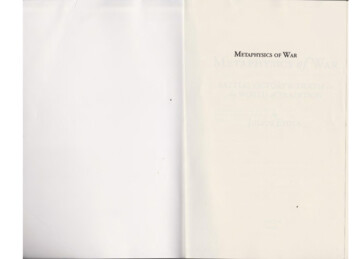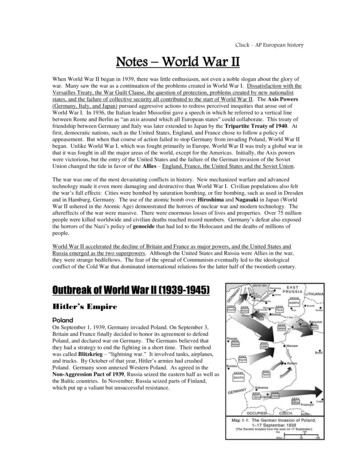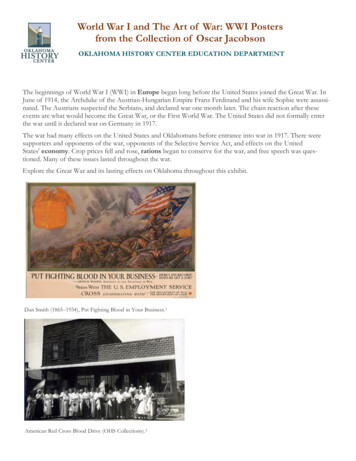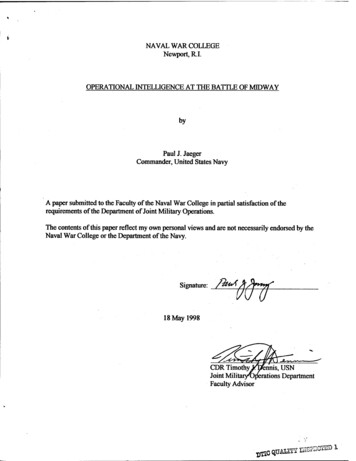
Transcription
NAVAL WAR COLLEGENewport, R.I.OPERATIONAL INTELLIGENCE AT THE BATTLE OF MIDWAYbyPaul J. JaegerCommander, United States NavyA paper submitted to the Faculty of the Naval War College in partial satisfaction of therequirements of the Department of Joint Military Operations.The contents of this paper reflect my own personal views and are not necessarily endorsed by theNaval War College or the Department of the Navy.Signature:/-&*418 May 1998CDR Timothy Jröennis, USNJoint MilitaryOperations DepartmentFaculty AdvisorDtlGISISBKiCESD
ScCtixrxty Cxsssii-i-CS-uion Tnis PcicfsREPORT DOCUMENTATION PAGE1. Report Security Classification: UNCLASSIFIED2. Security Classification Authority:3. Declassifiestion/Downgrading Schedule:4. Distribution/Availability of ReportDISTRIBUTION IS UNLIMITED.5. Name of Performing Organization: JOINT MILITARY OPERATIONS DEPARTMENT6. Office Symbol:CAddress: NAVAL WAR COLLEGE686 CUSHING ROADNEWPORT, RI 02841-12078. Title OPERATIONAL INTELLIGENCE AT THE BATTLE OF MIDWAY (J)9. Personal Authors:CDR PAUL J. JAEGER, USN10.Type of Report: " FINAL11. Date of Report: 18 MAY 199812.Page Count: 2113.Supplementary Notation:A paper submitted to the Faculty of the NWC in partialsatisfaction of the requirements of the JMO Department. The contents of this paperreflect my own personal views and are not necessarily endorsed by the NWC or theDepartment of the Navy.14. Ten key words that relate to your paper: OPERATIONAL, INTELLIGENCE, MIDWAY,CRYPTANALYSIS, SIGINT, NIMITZ, LAYTON, ROCHEFORT, DECISION-MAKING, WWII15.Abstract: The Battle of Midway showcased the application of operational intelligenceas a function of operational art. Planning and execution for the Midway operationrequired fusion of strategic, operational and tactical intelligence by the commandersinvolved; most notably Admiral Chester Nimitz. Having fully integrated operationalintelligence into his decision-making—with emphasis on enemy intent derived from codebreaking—Nimitz designed an operation that was truly the turning point of war in thePacific.Four main lessons about operational intelligence emerge as a function ofoperational art: 1) To be effective, operational intelligence requires the existence,in peacetime, of a theater-wide system for collecting, processing, evaluating anddisseminating intelligence information to the operational commander; 2) Integration ofstrategic/operational/tactical level intelligence is key to victory; 3) Operationalplanning based on enemy intent rather than enemy capability treads on dangerous groundrely on enemy intentions only when you possess absolutely reliable information; and 4)the operational commander must have vision to see where intelligence can help hisdecision-making.The proper, insightful and confident use of fused, finished operationalintelligence allowed Admiral Nimitz to extract unambiguous indications of enemy intentand develop an operational plan that capitalized on own force strength and criticalenemy weaknesses. In the end, the skillful and effective use of operational art provedthat a numerically inferior force can, under enlightened leadership, defeat anotherwise superior foe. It is an enduring lesson that stands the test of time.16.Distribution /Availability ofAbstract:Unclassified17.Abstract Security Classification:18.Name of Responsible Individual:19.Telephone:841-6461Same As RptDTIC UsersUNCLASSIFIEDCHAIRMAN, JOINT MILITARY OPERATIONS DEPARTMENT20.Office Symbol:Security Classification of This Page UnclassifiedDTIC QUALITY EHEPECTED
Abstract ofOPERATIONAL INTELLIGENCE AT THE BATTLE OF MIDWAYThe Battle of Midway showcased the application of operational intelligence as a functionof operational art. Planning and execution for the Midway operation required fusion of strategic,operational and tactical intelligence by the commanders involved; most notably Admiral ChesterNimitz. Having fully integrated operational intelligence into his decision-making—with emphasison enemy intent derived from code breaking—Nimitz designed an operation that was truly theturning point of war in the Pacific.Four main lessons about operational intelligence emerge as a function of operational art:1) To be effective, operational intelligence requires the existence, in peacetime, of a theater-widesystem for collecting, processing, evaluating and disseminating intelligence information to theoperational commander; 2) Integration of strategic/operational/tactical level intelligence is key tovictory; 3) Operational planning based on enemy intent rather than enemy capability treads ondangerous ground—rely on enemy intentions only when you possess absolutely reliableinformation; and 4) The operational commander must have vision to see where intelligence canhelp his decision-making.The proper, insightful and confident use of fused, finished operational intelligence allowedAdmiral Nimitz to extract unambiguous indications of enemy intent and develop an operationalplan that capitalized on own force strength and critical enemy weaknesses. In the end, the skillfuland effective use of operational art proved that a numerically inferior force can, under enlightenedleadership, defeat an otherwise superior foe. It is art enduring lesson that stands the test of time.19980825 068
OPERATIONAL INTELLIGENCE AT THE BATTLE OF MIDWAYThe operational commander applies operational art to the planning and execution of acampaign or major operation by synchronizing many operational functions. The Battle ofMidway showcased the application of operational intelligence—particularly that embodied bycode breaking—as a function of operational art. Planning and execution for the Midwayoperation required fusion of strategic, operational and tactical intelligence by the commandersinvolved; most notably Admiral Chester Nimitz. Nimitz's skillful and effective use ofoperational intelligence has provided an enduring lesson that has stood the test of time.Operational Intelligence Defined1In order to discuss the application of intelligence as operational art at the Battle ofMidway, one must first understand just what operational intelligence is. Simply stated,operational intelligence is concerned with information required to plan major operations orcampaigns. Far from completely distinct in relation to the other two levels of war, operationalintelligence is closely intertwined with its strategic and tactical counterparts. In fact, they areoften mutually dependent. As a result, operational intelligence is, more often than not, acomposite of strategic and tactical intelligence.Operational intelligence does, however, hold unique ground of its own. In contrast totactical intelligence, it focuses on collection, identification, location and analysis of the enemy'scritical factors—including his strategic and operational centers of gravity. It is used to protectone's own center of gravity, unmask an enemy's deception, and protect one's own plans andintentions from enemy interception. Operational intelligence should also provide adequateindications and warning of potential hostile action focusing both on qualitative and quantitative
differences in the enemy forces over time—information critically important for the operationalcommander's ability to plan, prepare and execute a major operation or campaign.In continued contrast to tactical intelligence, which focuses largely on measurablefactors, operational intelligence must deal with intangible factors such as morale, discipline, andcombat readiness. Patterns of major force employment and the personalities/peculiarities in thecommand style of enemy operational commanders must also be considered. Finally, operationalintelligence must foresee events for several weeks or even months ahead. While a tacticalcommander can adjust his course of action relatively quickly to unanticipated changes in thebattle situation, the operational commander cannot change the employment of his own forcesonce a major operation or campaign is underway without major problems and high risks.Code Breaking as the Strategic and Operational CenterpieceTo be effective, operational intelligence requires the existence, in peacetime, of atheater-wide system for collecting, processing, evaluating and disseminating intelligenceinformation to the operational commander. Without its existence in peacetime, the intelligencesystem contribution in war will almost certainly be a critical weakness. Numerous methods ofproducing intelligence have been practiced throughout history and are as relevant today as everbefore. It is safe to assume that the synergistic fusion of multiple methods from multiple sourceswill produce the clearest picture of the real or potential battlefield. Dependent on the situationthough, one particular method may dominate. During World War n, the intentional intercept ofenemy communications (referred to as radio intelligence then, and more broadly as signalsintelligence today) is such an example. Though certainly not an end onto itself, code breaking—a process closely associated with radio intelligence—was an integral part of the theater-wideintelligence system; a part that would play a predominant role in the planning, preparation and
execution of the Midway operation. Prior to World War n, the principal source of intelligenceon the Japanese navy was the intercept of their radio traffic made by a network of listening postsand then processed in three cryptanalysis centers. American insight into the Japanese navy wasfurther strengthened by information garnered through attaches and spies. Radio intelligence,however, remained the principal source throughout the war.The Navy's Combat Intelligence Unit at Pearl Harbor was the nerve center for codebreaking activity. Known as Station "Hypo", it listened to Japanese radio traffic along with it'ssister sites "Cast" in the Philippines (first in Cavite and later in Corregidor; Cast was replaced byStation Belconnen—a site in Melbourne, Australia after the fall of the Philippines), and "Negat"in Washington, DC. They intercepted enemy radio communications, analyzed traffic, locatedand tracked transmitters, and decoded messages through cryptanalysis. The three stationsgenerally operated as a unit; sharing insights, breakthroughs and recoveries related to the topJapanese naval code: JN-25. In the Pacific area, the system included subsidiary receivingstations with high-frequency direction finders. These stations were situated in a great arc fromDutch Harbor in the Aleutians, through Hawaii, to the Philippines. They listened continually,pinpointed transmitters, and reported directly to Station Hypo. The actual process of codebreaking rarely yielded more than 10-15 percent of a message. Detailed analysis conducted bymen who had worked together for years and understood their target both inside and out producedthe rest. These men were often described as sailors, linguists and puzzle fiends all wrapped upin one Often, the name of a particular ship suggested that another ship was in company with it.Place names from a previous operation would surface again in a subsequent transmission. Mostoften, a familiar operator's touch would give the source away; the unit's call letters could
change, but the operator's "fist"—as unique as a fingerprint to a trained ear—would neverchange.2The fruits of code breaking served not only operational level commanders, but strategicand tactical commanders as well. The strategic value of code breaking and the tactical utilitythat can come from it was clearly seen in 1936 when radio intercepts of the post-modernizationtrials of the Japanese battleship NAGATO revealed that the rehabilitated World War Idreadnought had made better than 26 knots with her rebuilt turbines—an increase of 2 Vz knotsover others in her ship class. As a result, the design specification of our NORTH CAROLINAclass battleships was changed from a top speed of 24 knots to one of 27 knots. That single pieceof strategic intelligence would ultimately give our new battleships a one-knot superiority overtheir Japanese opponents—an important wartime tactical advantage.3Giving credence to the belief that strategic and operational intelligence are intertwinedand mutually dependent, in April, 1942, with the Japanese clearly on the offensive and directlyon the heels of a Japanese raid in Ceylon, Admiral Ernest King, Commander in Chief, U.S. Fleet(CominCh), communicated directly with Commander Joseph J. Rochefort, Jr., commander ofstation "Hypo." King wanted a long range estimate of Japanese naval intentions based on thecurrent flow of radio intercepts. Rochefort's response stated: 1) Japanese operations in theIndian Ocean were over; the fleet was on its way home, 2) they weren't going to attack Australia,3) an operation south of Rabaul was being planned, and 4) signs of something else were brewingin the Pacific.4 His conclusions—serving both the strategic commander (King) and theoperational commander (Nimitz)—were remarkably accurate. The "something else" turned outto be Midway.
Convincing the Operational CommanderThe value placed on intelligence has varied greatly throughout history. Historians canpoint to Clausewitz and Sun Tsu to draw drastically different conclusions. When all is said anddone, the ultimate value of intelligence will likely be proportional to the operationalcommander's confidence that it will have a positive impact on his unique situation. To beeffective, operational intelligence must be believed and espoused by the operational commanderand his staff. It must compete with the preconceived ideas (good and bad) of its users. Tocompound matters, because of its composite strategic/operational/tactical nature, many elementsof the intelligence system will not be under the operational commander's immediate or indirectcontrol. It is therefore not uncommon for commanders and staffs to misapply previousexperience or ignore valuable intelligence.5In Admiral Nimitz's case, his first impression with the code breaking aspect ofoperational intelligence was not a good one. Shortly after his arrival at Pearl Harbor, heinspected Station Hypo. He had shown polite interest, asked a few questions, and departed. Hewas not impressed. If the radio intelligence units could do what they were set up to do and do itefficiently, why had they not warned of the impending attack on Pearl Harbor?6 The outwardlydisheveled appearance of Rochefort's crew certainly would not have helped sway the admiral'sopinion. Nimitz's own preconceived idea of an intelligence failure would have to be won over.That was the task confronting Commander Edwin Layton, the Pacific Fleet intelligence officer.From their first meeting, Layton, a holdover from Admiral Kimmel's staff, began toimpress Nimitz with both his detailed knowledge of the location and movements of Japanesenaval forces and a remarkable understanding of Japanese psychology. Nimitz had beenprophetic when, having been asked by Layton for transfer to a sea billet, replied, "You can kill
more Japs here than you could ever kill in command of a destroyer flotilla."7 Using decryptedmessages when preparing his daily intelligence brief for Nimitz, Layton continued to accuratelypredict enemy moves, gained yet more of the admiral's confidence, and, together withRochefort, was able to overcome the admiral's preconceived notion of Station Hypo. By April,1942, four months after his arrival as Commander-in-Chief Pacific (CincPac), Nimitz had cometo trust the radio intelligence and became very cooperative and understanding. Nimitz was a"thinking leader, a real intellectual", who comprehended the intelligence mentality. Havingcome to appreciate the value of Hypo's work, he insisted that Rochefort have complete freedomto carry on his essential, if off-beat activity. "You are supposed to tell us what the Japanese aregoing to do," he told Rochefort, "and I will then decide whether it is good or bad and actaccordingly."8 In fact, by the onset of the Battle of the Coral Sea, Nimitz viewed Station Hypo'sproduct as so essential that he made a request to CominCh that Rochefort's team concentrate onreading "today's traffic today while it is of value to forces afloat" while Station Negat'scryptanalysts in Washington "undertake code recovery on back traffic." King concurred.Subsequently, Rochefort and Hypo's accuracy at predicting and monitoring of the events at theCoral Sea persuaded Nimitz to trust Rochefort over and above the often conflicting assessmentsbeing made by naval intelligence in Washington—a confidence critical to success at Midway.9The trust Nimitz developed in Layton and Rochefort was instrumental to his ability to useintelligence in his operational planning. The value put on operational intelligence in the Pacifichad come a long way in the past fifteen months. Had Nimitz conducted "business as usual" uponhis arrival, the information gleaned by Hypo may never have even come into play. Indicative ofthe sad state of operational intelligence immediately preceding World War n, when Laytonreported aboard the Pacific Fleet flagship in December, 1940, the fleet had never had a full-time
intelligence officer. The job had always been assigned as an additional duty to a member of thestaff. To Layton's astonishment, he found that the safe placed into the bulkhead of battleshipPENNSYLVANIA to house the fleet's most secret documents contained just eighteen filefolders; most of them empty. Next to newspaper clippings from the 1920's on South Africa andthree military dossiers about France (totally unrelated to the Pacific) was a single monographgiving only the broadest of generalities about the Japanese navy. Layton, who served two tours inJapan—three years of language study froml929 to 1932 and as assistant naval attache from 1937to 1939—was personally aware of numerous intelligence reports that would have shedsignificant light on Japanese capabilities. To find such an austere compilation of intelligence onthe flagship shed a poor light on the existing status of intelligence integration within theoperating forces.10Nimitz, however, understood and appreciated the operational intelligence perspective. Inaddition to his daily 0800 intelligence brief, he encouraged Layton to go to his office at any timewith new bits of information on a priority basis—the only member of his staff, aside from theflag secretary, afforded that privilege. Nimitz clearly demonstrated an appreciation thatoperational intelligence was essential to sound decision making when he told Layton:"I want you to be the Admiral Nagumo of my staff. I want your every thought,every instinct as you believe Admiral Nagumo might have them. You are to seethe war, their operations, their aims, from the Japanese viewpoint and keep meadvised what you are thinking about, what you are doing, and what purpose, whatstrategy, motivates hour operations. If you can do this, you will give me the kindof information needed to win this war."11Through this task, Nimitz demonstrated that the personalities and peculiarities in the commandstyle of his enemy counterpart would figure into his own decision making.
Of note, though he was not an operational commander, Admiral King too appreciated thevalue of American code breaking operations; and also the dire consequences of what thecompromise of code breaking activities would cause. As the Japanese closed in on Americanforces in the Philippines, he personally ordered the evacuation of Station Cast lest capture andsubsequent torture reveal the secrets of American radio intelligence exploitation.12Employing Operational Intelligence to Conceive the PlanPlanning for the Midway operation began long before the actual event and showed thedirect influence of operational intelligence. Armed with Rochefort's estimate of upcomingJapanese operations in the vicinity of New Guinea/Rabaul and later in the Pacific Ocean, Nimitzthought it unlikely that the Japanese would bypass Midway, the westernmost fortified U.S.outpost in the central Pacific. Prior to action in the Coral Sea, he understood that he could notrisk such losses in defending New Guinea that he would be helpless to counter the later PacificOcean offensive. If the Japanese would act as Rochefort was predicting, they would either haveto seize or bypass Midway—and thus far the Japanese had shown no tendency to bypass strongpoints.13 Reviewing the patterns of enemy force employment is a key tenet of operationalintelligence. If the central Pacific was a Japanese objective, then seizing Midway was a likelycourse of action.Piecing together a "code within a code" (the infamous AF equating to Midway),Rochefort's Combat Intelligence Unit concluded that Midway was indeed the probable targetand began publishing estimates stressing it as such.14 By mid-May, Nimitz had assumed forplanning purposes that the Japanese would attack Midway and that this blow would be precededby a secondary attack on the Aleutians.15
Many high ranking decision makers were not convinced. In fact, since the sameintercepts used to conclude Midway was the target also referred to Aleutian area targets, manyofficers believed either Hawaii or the West Coast was the real objective.16 The Army Air Forcewas expecting a raid on San Francisco and General Delos Emmons, head of the HawaiiDepartment, went so far as to provide an elementary lesson in intelligence procedures, statingthat it would be more prudent to plan on the basis of everything the enemy was capable of doingrather than basing an estimate on the enemy's probable intentions. In response to Emmons'warning, Nimitz assigned one of his staff officers, CAPT James Steele, to reassess the findingsof fleet intelligence by challenging every bit of information put forward by Layton, Rochefort,and their assistants.17 Whether or not Nimitz's task to Steele is viewed as placating Emmons(probable) or as a final confirmation of his trust in the code breakers' estimate is immaterial. Indoing so, Nimitz quite rightly allowed room to challenge legitimate differences in interpretation.What Nimitz did not do, and had no intention of doing, was to diffuse his efforts andscatter his limited forces trying to defend every conceivable Japanese attack. The situation wasdesperate and he knew it.I8 After Coral Sea, it was evident that Japan was concentrating herfleet for movements of major importance against the Aleutians and Midway. Station Castrevealed that the Japanese had canceled their plan to take Port Moresby in New Guinea byamphibious assault To Nimitz, that meant practically every Japanese warship, including all thecarriers, would be available for the attack on Midway. Station Hypo pieced together aremarkably complete intelligence estimate indicating that the Midway expedition was composedof a striking force centered around four front-line carriers, a support force and an occupationforce. The accuracy of this intelligence estimate was essential to operational planning since U.S.forces were not only inferior in number, but also tired, hurt, and potentially late in arriving.
(LEXINGTON had been sunk, YORKTOWN badly damaged; remainders of the air groupsurgently required reorganization and rest.) In Nimitz's own words: "It was evident, if estimatesof the enemy's strength and intentions were true, that the situation was most serious."19Eleven days short of the eventual engagement, Rochefort reported an immensebreakthrough—they had intercepted and broken 80-85% of the Combined Fleet operation order.Not only were they now aware of Japan's broad intention for her Combined Fleet, but theCombat Intelligence Unit had broken the date-time cipher to the point where they could predictthat enemy operations would begin against the Aleutians on 3 June and against Midway on 4June. But, rather than convincing the skeptics at CincPac headquarters, the precise details of thisintercept only deepened the skeptics' suspicions. Rhetorical questions abounded. Why wouldthe whole Combined Fleet be assigned to capture one tiny Central Pacific atoll and a couple ofuseless islands in the Aleutians? Where these messages fakes, intended to deceive? Why wouldJapan transmit such critically sensitive information on radio in the first place? Even with thesecurest of codes, this type information would not normally be sent via radio where it could berecorded, scrutinized and perhaps cryptanalyzed.20 In the minds of those yet unconvinced, thepotentially disastrous problem of "mirror imaging" was real.To Nimitz's credit, he pointed out that the Japanese could be operating in strength inorder to meet any American opposition or that their main objective might even be to draw outthe inferior U.S. Pacific Fleet and destroy it (classic Mahanian strategy). Transmission by radiocould also mean that the Japanese were operating on so tight a schedule that they couldn't getorders distributed in time by any other means. As a final check, he tasked Layton to review allthe data he had from radio intercept and from all other sources to derive as precise a forecast ofthe coming attack as was possible. Nimitz reminded him: "I want you to be specific. After all,10
that is the job I have given you—to be the admiral commanding the Japanese forces and tell uswhat you're going to do." The precision with which Layton responded: ". the carriers willprobably attack Midway on the morning of the 4* of June. they'11 come in from the northweston bearing of 325 degrees and they will be sighted at about 175 miles from Midway, and thetime will be about 0600 Midway time", and the belief that our code breaking successes wereunknown to the Japanese, convinced Nimitz to base his plans on the assumption that theintelligence estimates were correct.21In the end, Nimitz chose the exception to the implied rule: when deciding to plan againsteither capabilities or intentions, rely on enemy intentions only when you possess absolutelyreliable information. Reliance on intentions is always risky since operational intelligence—more so than either strategic or tactical intelligence—is very susceptible to deception. Had theJapanese been aware that we were reading their encrypted traffic and used that knowledge todeceive and ambush the U.S. Pacific Fleet, the outcome at Midway would certainly have beenvery different.Fusing the Pieces to Execute the PlanNimitz knew that carrier-borne air power was the decisive naval weapon in the vastPacific theater and that the Japanese navy's operational center of gravity was their carrierforce.22 Using the insight gleaned from intercept of the operations order, it was clear to Nimitzthat in Japanese disposition of forces, the crucial elements were Nagumo's four carriers.Without the carriers, Nagumo could not knock out Midway's ground and air defenses, nor couldhe provide a concentration of air power great enough to cover the other components of his fleet.Nimitz knew he would have to plan to destroy the Japanese carriers.2311
Execution of the Midway operation was dependent on a plan that took into account thecritical factors affecting both his own and the enemy forces. Fusion of strategic and operationalintelligence had gotten him to the brink of the battle; continued fusion of operational and tacticalintelligence would allow him to place his own forces into the advantageous position he sodesperately needed. From there, the tactical proficiency of his subordinate commanders wouldwin or lose the battle.Admiral Raymond Spruance was a first rate organizer and strategist who Nimitz wasconfident would calculate coolly under stress. Pressed into command of Task Force 16 when it'snormal commander, Admiral William Halsey was taken ill, he saw at once the advantage ofplacing his force on Nagumo's flank and the possibility of attacking the Japanese carriers whiletheir planes were raiding Midway. Spruance also made the prudent observation that the U.S.carrier forces should not proceed west of Midway in search of the enemy before the enemycarriers were substantially disabled. If they did, the Japanese might alter their plans and head forPearl Harbor—leaving American forces bypassed and unable to intervene.24By acting on the operational intelligence available to them, the combined assets of TaskForces 16 and 17 (commanded by Rear Admiral Frank Jack Fletcher) could achieve surprise andcatch the enemy carriers in a vulnerable state. Assuming the Japanese Striking Force wouldbegin launching toward Midway at dawn, the U.S. task forces would launch a strike at thecarriers upon first report of enemy location, course, and speed from U.S. search planes. Withgood timing and good luck, they would catch the Japanese carriers with half their planes awayattacking Midway. With better luck and better timing, they might catch the enemy carriers whilethey were recovering the Midway attack group—or even better yet, while rearming and refuelingthe recovered planes.12
The U.S. would need every carrier it had to engage the superior Japanese forces, butunfortunately, after Coral Sea, LEXINGTON had been sunk and YORKTOWN was badlydamaged. Arriving at Pearl Harbor on 27 May, the estimated repair time for YORKTOWN was90 days. Armed with a precise timetable of Japanese intentions though, Nimitz was able toaccurately bound the repair time available. Since it only needed to be battleworthy in order toparticipate in the Midway operation, Herculean efforts over three days would prove to be justenough.26Armed with the knowledge from radio intercept that Japanese sea planes and submarineswere enroute to scout Pearl Harbor, Nimitz pre-stationed a vessel in the lagoon at French FrigateShoals. Since sea planes could not complete the long flight from the Marshall Islands to Hawaiiwithout refueling from tanker-submarines, failure to establish the rendezvous point at FrenchFrigate Shoals meant the sea planes never got to their destination. By the time the subs reachedPearl Harbor, Task Forces 16 and 17 had already departed. Complementing t
planning based on enemy intent rather than enemy capability treads on dangerous ground- rely on enemy intentions only when you possess absolutely reliable information; and 4) the operational commander must have vision to see where intelligence can help his decision-making. The proper, insightful and confident use of fused, finished operational

